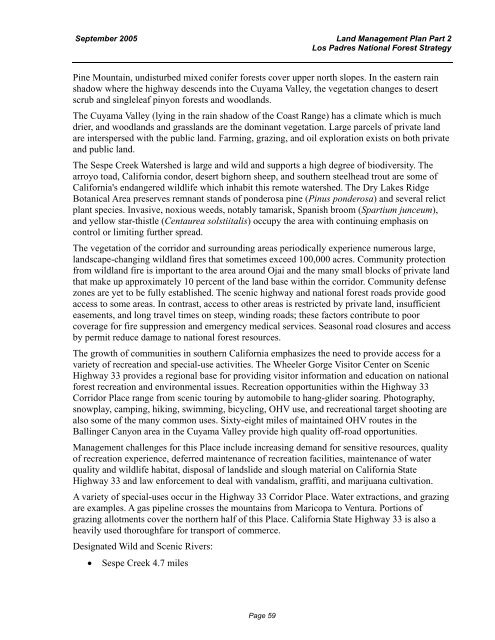Land Management Plan - Part 2 Los Padres National Forest Strategy
Land Management Plan - Part 2 Los Padres National Forest Strategy
Land Management Plan - Part 2 Los Padres National Forest Strategy
You also want an ePaper? Increase the reach of your titles
YUMPU automatically turns print PDFs into web optimized ePapers that Google loves.
September 2005 <strong>Land</strong> <strong>Management</strong> <strong>Plan</strong> <strong>Part</strong> 2<br />
<strong>Los</strong> <strong>Padres</strong> <strong>National</strong> <strong>Forest</strong> <strong>Strategy</strong><br />
Pine Mountain, undisturbed<br />
mixed conifer forests cover upper north slopes. In the eastern rain<br />
shadow where the highway descends into the Cuyama Valley, the vegetation changes to desert<br />
scrub and singleleaf pinyon forests and woodlands.<br />
The Cuyama Valley (lying in the rain shadow of the Coast Range) has a climate which is much<br />
drier, and woodlands and grasslands are the dominant vegetation. Large parcels of private land<br />
are interspersed with the public land. Farming, grazing,<br />
and oil exploration exists on both private<br />
and public land.<br />
The Sespe Creek Watershed is large and wild and supports<br />
a high degree of biodiversity. The<br />
arroyo toad, California condor, desert bighorn sheep, and<br />
southern steelhead trout are some of<br />
California's endangered wildlife which inhabit this remote<br />
watershed. The Dry Lakes Ridge<br />
Botanical Area preserves remnant stands of ponderosa pine<br />
(Pinus ponderosa) and several relict<br />
plant species. Invasive, noxious weeds, notably tamarisk,<br />
Spanish broom (Spartium junceum),<br />
and yellow star-thistle (Centaurea<br />
solstiitalis) occupy the area with continuing emphasis on<br />
control or limiting further spread.<br />
The vegetation of the corridor and surrounding areas<br />
periodically experience numerous large,<br />
landscape-changing wildland fires that sometimes exceed<br />
100,000 acres. Community protection<br />
from wildland fire is important to the area around Ojai and<br />
the many small blocks of private land<br />
that make up approximately 10 percent of the land base within<br />
the corridor. Community defense<br />
zones are yet to be fully established. The scenic highway and national forest roads provide good<br />
access to some areas. In contrast, access to other areas is restricted by private land, insufficient<br />
easements, and long travel times on steep, winding roads; these factors contribute to poor<br />
coverage for fire suppression and emergency medical services. Seasonal road closures and access<br />
by permit reduce damage to national forest resources.<br />
The growth of communities<br />
in southern California emphasizes the need to provide access for a<br />
variety of recreation and special-use activities. The Wheeler Gorge Visitor Center on Scenic<br />
Highway 33 provides a regional base for providing visitor information and education on national<br />
forest recreation and environmental<br />
issues. Recreation opportunities<br />
within the Highway 33<br />
Corridor Place range from scenic<br />
touring by automobile to hang-glider soaring. Photography,<br />
snowplay, camping, hiking, swimming, bicycling, OHV us e, and recreational target shooting are<br />
also some of the many common uses. Sixty-eight miles of maintained<br />
OHV routes in the<br />
Ballinger Canyon area in the Cuyama Valley provide high quality off-road opportunities.<br />
<strong>Management</strong> challenges for this Place include increasing demand for sensitive resources, quality<br />
of recreation experience, deferred maintenance of recreation<br />
facilities, maintenance of water<br />
quality and wildlife habitat, disposal of landslide and slough<br />
material on California State<br />
Highway 33 and law enforcement to deal with vandalism, graffiti,<br />
and marijuana cultivation.<br />
A variety of special-uses occur in the Highway 33 Corridor Place. Water<br />
extractions, and grazing<br />
are examples. A gas pipeline crosses the mountains from Maricopa<br />
to Ventura. Portions of<br />
grazing allotments cover the northern half of this Place. California<br />
State Highway 33 is also a<br />
heavily used thoroughfare for transport of commerce.<br />
Designated Wild and Scenic Rivers:<br />
• Sespe Creek 4.7 miles<br />
Page 59
















